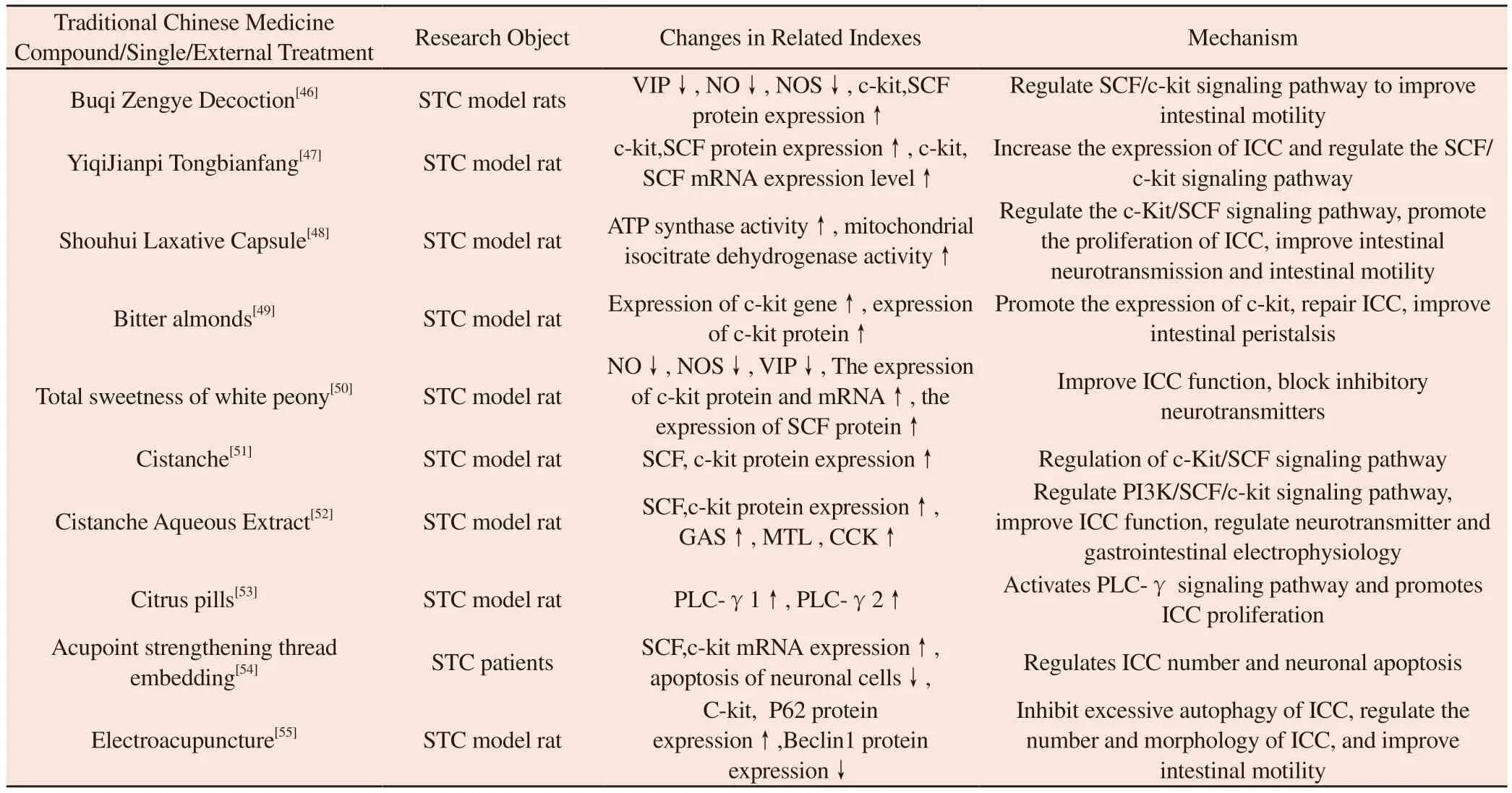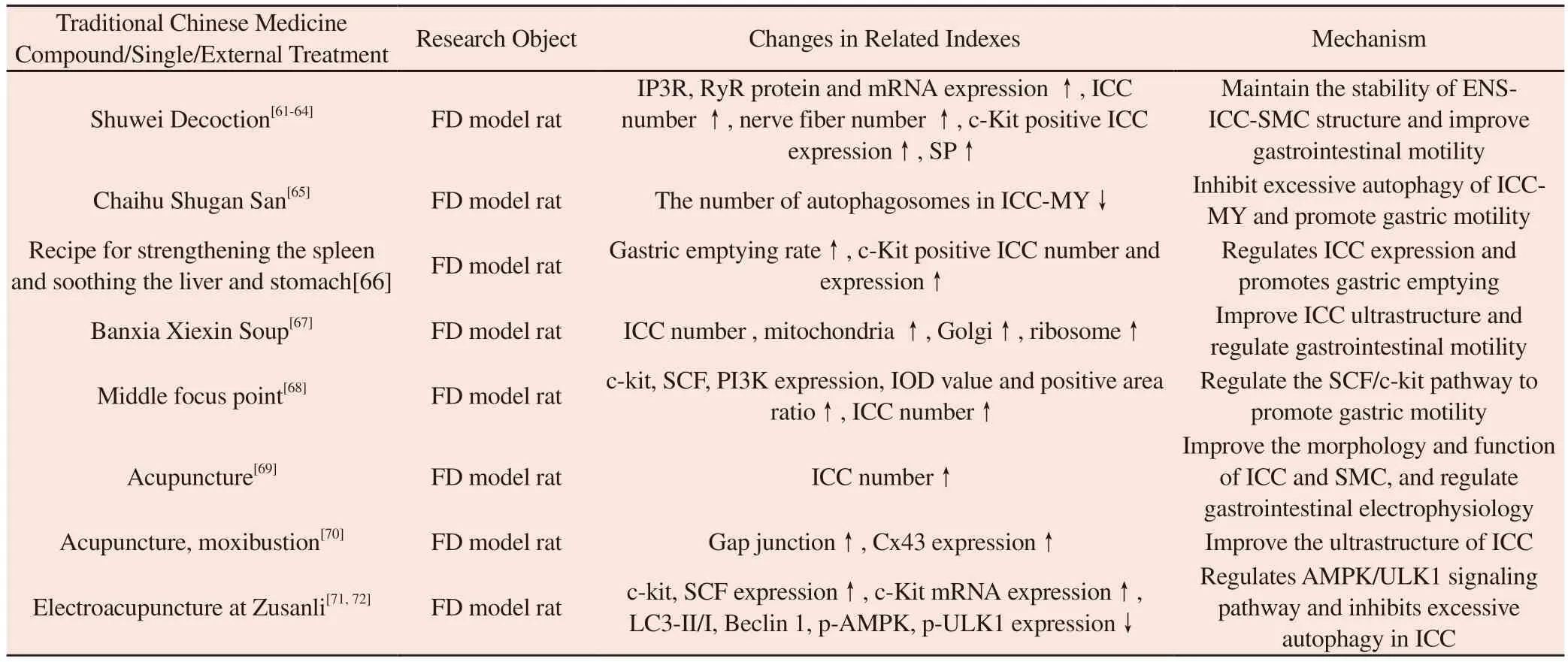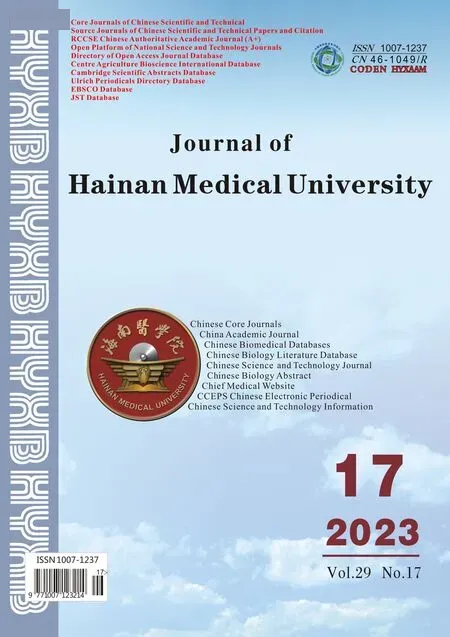Research progress of TCM regulation of Cajal interstitial cells in the treatment of functional Gastrointestinal diseases
WEI Rong-huang, LIANG Ya-lin, HUANG Xue-xia, MENG Hua-ying, HUANG Maoguang, LUO Feng, XIE Sheng
1.Graduate School of Guangxi University of Traditional Chinese Medicine, Nanning 530001, China
2.The First Affiliated Hospital of Guangxi University of Traditional Chinese Medicine, Nanning 530001, China
Keywords:
ABSTRACT Interstitial cells of Cajal are a different class of cells with unique ultrastructure, molecular phenotype and function, and their main function is to generate slow waves, thereby triggering gastrointestinal pacing and regulating gastrointestinal motility.They play an extremely important physiological role in coordinating the normal activities of the digestive system, and their number, shape and function abnormalities often have a certain impact on gastrointestinal motility.Functional gastrointestinal disease is a type of digestive system disease closely related to gastrointestinal motility.Relevant studies have shown that the pathogenesis of functional gastrointestinal disease is closely related to the abnormal number, morphology and function of Cajal interstitial cells.Regulating the shape and number of interstitial cells of Cajal,maintaining the normal operation of gastrointestinal electrophysiology, inhibiting excessive autophagy and activating related signaling pathways, etc., can improve gastrointestinal motility,thereby treating functional gastrointestinal diseases.This article will discuss the treatment of functional gastrointestinal diseases from traditional Chinese medicine compound, traditional Chinese medicine monomer, and external treatment of traditional Chinese medicine by regulating Cajal interstitial cells.
Functional gastrointestinal disorders (FGIDs) are a group of nonorganic diseases of the digestive system characterized by chronic and recurrent disease.In terms of epidemiology, a large-scale multinational study shows that the global incidence of FGIDs exceeds 40% and is increasing.Relevant studies have shown that the pathogenesis of FGIDs is closely related to gastrointestinal motility dysfunction, and interstitial cells of Cajal (ICC) are the pacemaker cells of gastrointestinal motility, and their number and morphological changes may affect the gastrointestinal motility.activities have some impact.A large number of studies have confirmed that traditional Chinese medicine can improve gastrointestinal motility by regulating ICC, thereby treating FGIDs.Based on this, this article reviews the regulation of ICC in the treatment of FGIDs by TCM compound, TCM monomer, and TCM external therapy, in order to provide new ideas for the majority of clinical workers.
1.Morphological characteristics and types of ICC
The ICC is an essential component of a gastrointestinal pacemaker device.In 1893, Spanish scientist Santiago Ramóny Cajal first discovered this type of cells in the gap between nerve endings and smooth muscle cells (SMC) in the gastrointestinal tract and described them as “primitive neurons”[1].ICCs are primarily located within the muscular layer of the gastrointestinal tract, and although they vary morphologically, they often have corresponding features that are considered valuable tools for their identification.These include: ① a large number of mitochondria and pits; ②discontinuous basal layer; ③ abundant intermediate filaments; ④moderately developed Golgi apparatus with few ribosomes and rough and smooth endoplasmic reticulum; Numerous gap junctions form a network with each other across the intestinal wall and smooth muscle cells[2, 3].ICC can be considered as a special population of smooth muscle cells, both of which are derived from common mesenchymal cells and share some of the same ultrastructural features, including pits and basal layers[4-6].It can be divided into different types according to its anatomical location, cell morphology,etc.: Intramuscular ICC (IC-IM): mainly located in the muscle layer of the stomach and large intestine, it is a bipolar cell in the circular and longitudinal muscle layers, They make close contact with nerve endings and form specific connections with smooth muscle cells.Intermuscular ICC (IC-MY): Mainly located in the space between the circular and longitudinal muscles, are multipolar cells in the intermuscular layer that passes through the gastrointestinal tract.Submucosal ICC (IC-SMP): Multipolar, with fine processes, located in the submucosal border of the colon muscle layer.Deep muscular layer ICC (IC-DMP): It is a specific type of ICC-IM in the annular muscular layer of the small intestine, which is mainly distributed along the deep muscular plexus of the small intestine[7-9].Studies have shown that ICC not only exists in the gastrointestinal tract, but is also widely distributed in the biliary tract, bladder, urethra, and uterus[10-12].
2.Electrophysiology of ICC
ICCs are pacemaker cells that generate electrical slow waves in gastrointestinal smooth muscle.Basic motion patterns of slow-wave tissues, such as peristalsis and segmentation in the gastrointestinal tract.The gastrointestinal tract has multiple tasks of ingesting nutrients at the right time, absorbing nutrients, and disposing of waste.These tasks are facilitated by several stereotyped motor patterns that build on the intrinsic rhythmicity of smooth muscle,producing phasic contractions in many regions of the gut.Phasic contractions are caused by periodic cycles of depolarization/repolarization, known as electronic slow waves, caused by intrinsic pacemaker activity.The ICC is electrically coupled to the SMC and generates and propagates pacemaker activity and slow waves.Relevant animal experiments have shown that the main conductances responsible for slow waves in mice are Ano1, Ca2+-activated Clchannels (CaCCs) and CaV3.2, a T-type voltage-dependent Ca2+channel.Release of Ca2+from ICC intracellular stores appears to be the initiating cause of pacemaker depolarization, activation of T-type currents provides voltage-dependent Ca2+entry into ICC, as slow waves propagate through the ICC network, Ca2+induces Ca2+release and Ano1 activation in ICC amplifies slow-wave depolarization.Slow waves are conducted to coupled SMCs, and depolarization caused by these events enhances the open probability of L-type voltage-dependent Ca channels, facilitating Ca entry and triggering contraction.The phasic contractions timed by the occurrence of slow waves provide the basis for movement patterns such as gastric motility and segmentation [13, 14].
Slow waves depend on Ca2+-activated Cl-channels (CaCCs)encoded by Ano1, which are required for normal gastrointestinal motility.The Na+/Ca2+action exchanger (NCX) regulates CaCCs currents in ICC.NCX is generally considered to be a Ca2+extrusion transporter, but this exchanger is capable of bidirectional movement of ions according to membrane potential and transmembrane gradients of Ca2+and Na+.The Ca2+exit mode scavenges Ca2+from the vicinity of ANO1 channels, maintaining the low open probability of these channels during the slow-wave interval.The Ca2+entry mode contributes to the continuous activation of CaCCs channels,forming a plateau phase of the slow wave.The plateau phase of the slow wave is a key determinant of gastrointestinal motility, as depolarization of this phase initiates action potentials (as in the small intestine and colon) or leads to sustained Ca entry (as in the stomach)by activating L-type SMCs the Ca2+channel.Ano1 in adults regulates gastrointestinal function by determining Ca transients and electrical activity based on Ano1 expression levels.Partial loss of Ano1 results in a shortened duration of Ca transients and slow-wave displays, whereas complete and extensive loss of Ano1 in ICC-MY results in a lack of slow-wave and asynchronous Ca transients [15-17].
3.ICC is involved in neurotransmission
Gastrointestinal motility relies on coordinated gut motor neurotransmission[18].Motor neurons' synaptic inputs from widely distributed premotor networks translate into action potential patterns that coordinate motor unit forces and motor behavior.Motor neurons insert between the central nervous system and the muscles,increasing and adjusting the final motor command.ICC is innervated by enteric neurons, which transmit neurotransmitters.Different ICC types express various receptors for different neurotransmitters, such as the M2 and M3 receptors of muscarinic ACh.The study found that both excitatory and inhibitory intestinal motor neurons are closely related to IC-DMP and ICC in IC-IM of the proximal and distal gastrointestinal tract.Morphological studies provide evidence that motor neurotransmission in the gut occurs not through loosely defined synaptic structures between nerves and smooth muscle,but through synapse-like contacts that exist between varicose nerve endings and ICC-IM.ICC-IM is coupled to smooth muscle cells through gap junctions, and the electrical responses elicited in ICC are conducted to muscle cells.Electrophysiological studies of wild-type and mutant animal stomachs lacking ICC-IM provide functional evidence for the importance of ICC in cholinergic and nitrogenergic motor neurotransmission.Synapse-like contacts between nerve endings and ICC-IM facilitate the rapid diffusion of transmitters to specific receptors on ICCs.ICC-IM also works by generating a single potential in the stomach, which helps increase the excitability of the fundus and antrum.Experiments with W/WV mutants lacking IC-IM in the stomach, lower esophageal sphincter,and pylorus suggest that these ICCs are key components of the neuromuscular junction.Cholinergic excitatory and nitrogenergic inhibitory neurotransmission is severely reduced in tissues lacking IC-IM, but not cholinergic or nitrogenergic neurons in W/WV mutants, suggesting some classes of ICC important role in enteric neurotransmission and predicts that loss of ICC in human dyskinesia may significantly impair neuromodulation of gastrointestinal motility[19 20].
4.ICC and SCF/c-kit pathway
ICCs are gastrointestinal mesenchymal cells that specifically express c-Kit and form cellular networks within the gastrointestinal muscle tissue[21].c-Kit, a specific marker of ICC, is a receptor tyrosine kinase that regulates the development and differentiation of several progenitor cells and is involved in intracellular signaling.In the gastrointestinal tract, c-Kit regulates the development of ICCs,which form gap junctions with SMCs in visceral smooth muscle and provide important regulatory functions[22, 23].The proliferation,differentiation and function of ICC are closely related to the activation of c-kit receptors on its surface[24].Evidence suggests that the activation of c-kit depends on its ligand, stem cell factor (SCF).The SCF/c-kit interaction results in receptor dimerization, activation of kinase activity, and initiation of multiple signaling pathways that have been shown to play a critical role in the regulation of ICC proliferation, differentiation, and function role[25-27].
5.ICC and FGIDs
FGIDs are a class of digestive system diseases closely related to gastrointestinal motility function.The incidence of FGIDs continues to increase worldwide.The refractory and repetitive nature of the disease itself has caused great distress to the majority of patients[28].Relevant evidence shows that the reduction of ICC number,ultrastructural changes, and dysfunction are associated with a variety of gastrointestinal motility disorders, so ICC represents a potentially valuable therapeutic target[29, 30].
5.1 Traditional Chinese medicine regulates ICC in the treatment of IBS
Irritable bowel syndrome (IBS) is a functional gastrointestinal disorder characterized by changes in stool pattern or frequency[31,32].Relevant studies have shown that the decrease in the number of ICCs, abnormal distribution and dysfunction are closely related to the pathogenesis of IBS[33, 34].Xu Hui[35] used Tongxie Yaofang to treat IBS model rats and found that it could reduce the protein expression of c-kit, S-SCF and M-SCF, and change smooth muscle contraction./SCF signaling pathway, improve colon motility, so as to achieve the purpose of treating IBS.Li Hui[36] used Yunpi Rougan Fang to treat constipation-predominant irritable bowel syndrome (IBS-C) model rats, and found that it could improve the ultrastructure, network structure and quantity of ICC in IBS-C rats, so that Accelerates bowel advancement and facilitates bowel movements.Yang Qian [37, 38]have shown that Mazhi Jiangzhuo Recipe can regulate the expression of c-kit and 5-HT, improve the number, morphology and function of ICC cells in intestinal tissue, promote the recovery of rhythmic contraction of the gastrointestinal tract, and improve the intestinal Hypersensitivity state and conduction function to treat IBS-C.In terms of external treatment, Li Kaige[39] used electroacupuncture to stimulate the “Dachangshu” and “Tianshu” points to treat IBS model rats, and found that it could improve the diarrhea symptoms in rats by reducing the hypersensitivity of the viscera.The mechanism of action may be closely related to its regulation of colonic c-kit and capsaicin receptor 1 (TRPV1) expression.Luo Xiongfei[40] showed that abdominal massage can increase the expression of c-Kit and nNOS in IBS rabbits and improve gastrointestinal motility, and its mechanism of action may be related to the structure of intestinal ENS-ICC-SMC.See Table 1 for details.

Tab 1 Traditional Chinese medicine regulates ICC in the treatment of IBS
5.2 Traditional Chinese medicine regulates ICC in the treatment of FC
Functional constipation (FC), also known as chronic idiopathic constipation, refers to functional bowel disease without organic etiology, characterized by difficulty in defecation and decreased frequency of defecation[41, 42].Relevant studies have found that ICC dysfunction is closely related to slow transit constipation(STC), and the number of ICCs in colon tissue and intramuscular network density of STC patients are significantly reduced[43-45].Liu Libing[46] used Buqi Zengye decoction to treat STC model rats,and found that it may regulate the SCF/c-kit signaling pathway by regulating the contents of VIP, NO, and NOS in the colon, thereby promoting intestinal motility.Wang Jianmin[47] showed that Yiqi Jianpi Tongfang may improve constipation symptoms in STC model rats by up-regulating the expression of ICC in colon tissue and regulating the SCF/c-kit signaling pathway.Zheng Shuze[48]used Shouhui Tongbian Capsules to treat STC model rats, and found that it may increase intestinal tissue enzyme activity, regulate c-Kit/SCF signaling pathway, increase the number of ICC, and improve intestinal neurotransmission to promote intestinal Power related.Xu Liyu[49] used bitter almond to treat STC model rats and found that it could regulate the expression of c-kit in colon tissue,improve the distribution and quantity of ICC, and thus promote colonic motility.Relevant studies have shown that total glycerin of Paeonia lactiflora can improve the symptoms of STC model rats by improving ICC function and blocking inhibitory neurotransmitters such as NO, NOS and VIP [50].Cistanche deserticola and Cistanche deserticola water extract can improve the defecation of constipated rats by regulating the SCF/c-kit and PI3K signaling pathways in the key links of ICC function[51, 52].Xia Xuting[53] showed that Zhizhu Pills can regulate the growth and development of ICC by activating the downstream signaling pathway PLC-γ of ICC,thereby improving gastrointestinal motility and treating STC model rats.Xie Zhennian[54] used intensive acupoint catgut embedding to treat STC patients, and found that it could improve the number and morphology of colonic ICC, regulate the expression levels of SCF and c-kit mRNA, and reduce neuronal apoptosis, thereby achieving the effect of treating constipation.He Zhaoxuan[55] used electroacupuncture to treat STC model rats, and found that it may improve gastrointestinal motility by regulating the autophagy of ICC and speeding up the recovery of the number and structure of ICC.See Table 2 for details.
5.3 Traditional Chinese medicine regulates ICC in the treatment of FD
Functional dyspepsia (FD) refers to functional gastrointestinal disorders including a series of gastrointestinal symptoms including epigastric pain, epigastric burning, postprandial fullness, nausea, and belching[56, 57].Relevant studies have shown that the pathogenesis of FD is closely related to the cellular changes, excessive autophagy and abnormal differentiation of ICC[58-60].Wang Xiaojuan [61]showed that Shuwei Decoction can treat FD model rats by regulating the expression of IP3 receptor (IP3R) and Ry receptor (RyR) protein and mRNA in ICC cells.Studies by Guo Xuan[62, 63], Hu Shujuan[64]showed that Shuwei Decoction may maintain the structural integrity of ENS-ICC-SMC by increasing the number of ICCs and improvingtheir morphology, regulating c-Kit positive ICC expression and SP level , thereby improving gastrointestinal motility disorders and treating FD.Zeng Lijun[65] showed that Chaihu Shugan Powder can promote gastric motility and treat FD by inhibiting excessive autophagy of ICC-MY.Li Xiaoyan[66] used Jianpi Shugan and Weifang to treat FD model rats, and found that it may play a therapeutic role by regulating the expression of ICC in the corresponding parts and promoting gastric emptying.Xing Degang[67] found that Banxia Xiexin Decoction may treat FD by affecting the ultrastructure of ICC.Qu Meng[68] treated FD model rats with Zhongzhuo acupoint therapy and found that it could increase the number of ICCs and improve gastric motility by regulating the SCF/c-kit pathway.Relevant studies have shown that acupuncture can improve the morphology and function of ICC and SMC, regulate gastrointestinal electrophysiology, and promote gastrointestinal motility[69].Hu Shuning[70] used acupuncture and moxibustion to treat FD model rats, and found that both can treat FD by regulating the expression of connexin 43 (Cx43) in the stomach and intestine and repairing the ultrastructure of ICC.Relevant studies have shown that electroacupuncture at Zusanli in the treatment of FD model rats can increase the number of ICCs and repair the ultrastructure,phosphorylated autophagy-related protein 1 (p-ULK1) and c-Kit mRNA expression, thereby regulating the AMPK/ULK1, SCF/c-Kit signaling pathway, thereby inhibiting the excessive autophagy of ICC, and improving gastrointestinal motility disorders[71, 72].See Table 3 for details.

Tab 2 Traditional Chinese medicine regulates ICC in the treatment of FC

Tab 3 Traditional Chinese medicine regulates ICC in the treatment of FD
6.Summary
ICC is a pacemaker cell that generates electrical slow waves in gastrointestinal smooth muscle, and has the function of transmitting neurotransmitters and regulating gastrointestinal motility.Changes in the number and morphological structure of ICC may have a certain impact on gastrointestinal motility.A large number of studies have shown that TCM compounds, TCM monomers, and TCM external therapy can regulate the shape and quantity of ICC,maintain the normal operation of gastrointestinal electrophysiology,inhibit excessive autophagy of ICC, regulate the expression of corresponding proteins, and activate related signaling pathways.Improve gastrointestinal motility and treat FGIDs.At the same time,it is not difficult to find some limitations in the existing research: 1)most of the studies are animal experiments, lacking corresponding clinical randomized controlled trials; 2) different traditional Chinese medicine prescriptions, traditional Chinese medicines and external Therapeutic methods can treat FGIDs by regulating ICC, and its mechanism of action needs to be further explored.In the future,we can continue to start with ICC, carry out high-quality clinical randomized controlled trials, and further clarify the mechanism of Chinese medicine regulating ICC in the treatment of FGIDs, so as to provide high-level evidence-based medical evidence for clinicians.
Authors' contribution
Wei Ronghuang: article idea conception and writing
Liang Yalin: Retrieving Literature
Huang Xuexia: Retrieving Literature
Meng Huaying: Arranging documents
Huang Maoguang: Arranging documents
Luo Feng: Check the references
Xie Sheng: Check the quality of the article and provide article ideas, as well as authenticity and feasibility.
 Journal of Hainan Medical College2023年17期
Journal of Hainan Medical College2023年17期
- Journal of Hainan Medical College的其它文章
- Research progress on the regulation mechanism of non-coding RNA on ankylosing spondylitis
- Anesthetic effect of phenobarbital sodium on female BALB/c mice
- Abnormal expression and significance of circ-CBLB/miR-486-5p in patients with rheumatoid arthritis of spleen deficiency and dampness excess type
- Inhibitory effect of thymoquinone on neuroinflammation in Parkinson's disease model by regulating NLRP3 inflammatory bodies
- Effect of Astragalus-hawthorn on ovarian reproductive function and inflammatory mechanism of action in rats with polycystic ovary syndrome
- Effect of estrogen pretreatment in GnRH antagonist protocol-Metaanalysis
